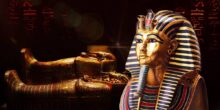Egyptian Queens: Architects of Civilization and Symbols of Power

Table of contents
Women played a crucial role in shaping the history of ancient Egypt, with many queens leaving a lasting impact not only on governance but also on the cultural and architectural advancements of their time. In this article, we explore some of the most influential Egyptian queens, their remarkable stories, and the historical monuments that preserve their legacy.
Queen Nitocris (c. 2150 BC)
Nitocris, also known as Neithikret or Nit Aqrty, is considered one of the earliest female rulers of Egypt. However, historians still debate the authenticity of her existence. According to the Greek historian Herodotus, Nitocris orchestrated one of history’s most ingenious acts of revenge. Following the assassination of her brother, she ascended the throne and meticulously planned her retaliation. She invited the conspirators to a grand banquet inside an underground chamber, only to have the hall flooded with Nile waters, drowning all her enemies. This act solidified her reputation as a symbol of intelligence and power.
Queen Hatshepsut (1479–1458 BC)
Hatshepsut, the daughter of Pharaoh Thutmose I and the wife of Thutmose II, took the throne after the death of her husband. Since the rightful heir, Thutmose III, was too young to rule, Hatshepsut initially governed as a regent before officially declaring herself pharaoh with the support of the priesthood, claiming divine descent from the god Amun.
During her reign, Egypt experienced a period of remarkable prosperity. She reopened quarries and mines in the Sinai Peninsula, significantly boosting Egypt’s wealth. Additionally, she expanded trade routes, organizing major expeditions such as the famous voyage to the Land of Punt. Hatshepsut was also a patron of monumental architecture, with her most notable project being the stunning mortuary temple at Deir el-Bahari. She passed away in 1457 BC, likely due to diabetes or cancer, and remains one of Egypt’s most celebrated rulers.
Queen Nefertiti (1370–1330 BC)
Nefertiti, whose name means “The Beautiful One Has Come,” did not rule Egypt independently but played a significant role alongside her husband, Pharaoh Akhenaten. Some scholars suggest she may have briefly ruled after his death.
She was a key supporter of Akhenaten’s religious revolution, which sought to replace Egypt’s polytheistic traditions with the worship of a single deity, the sun god Aten. Together, they moved Egypt’s capital to Akhetaten (modern-day Amarna) and commissioned grand temples to honor Aten. Art and inscriptions from the period depict Nefertiti with unprecedented prominence, engaging in activities typically reserved for pharaohs.
Her tomb has never been discovered, sparking theories that she may have been buried in a hidden chamber or remains undiscovered. Today, her iconic bust, housed in the Neues Museum in Berlin, stands as one of the most recognized symbols of ancient Egypt.
Queen Twosret (1191–1189 BC)
Following in the footsteps of Hatshepsut, Twosret ruled Egypt as an independent monarch after the deaths of her husband, Pharaoh Seti II, and his heir. As queen, she played a crucial role in completing her funerary temple and oversaw the construction of elaborate tombs, including her own in the Valley of the Kings. In inscriptions, she is depicted performing religious rituals, further cementing her authority as Egypt’s supreme ruler.
Queen Cleopatra VII (69–30 BC)
Cleopatra VII, daughter of Pharaoh Ptolemy XII, inherited the throne alongside her brother, Ptolemy XIII. However, a power struggle led to her exile. Seeking support, she allied with Julius Caesar, securing her return to power after defeating her brother’s forces. She later ruled jointly with her younger brother, Ptolemy XIV, before ultimately governing Egypt alone.
Cleopatra played a pivotal role in strengthening Egypt’s economy through agricultural and trade reforms. She strategically maintained diplomatic relations with Rome through alliances with Julius Caesar and later Mark Antony, resisting external threats to Egypt’s sovereignty.
Despite her military efforts, she was defeated in the Battle of Actium (30 BC) against Rome and retreated to Egypt. Her death remains a mystery, with theories ranging from suicide by poison to an asp bite. Her tomb has never been found, adding to the intrigue surrounding her life and legacy.
Conclusion
Egyptian queens were not merely consorts but formidable leaders who shaped the course of history. Their reigns marked periods of political stability, economic growth, and monumental achievements. Their legacies live on through their enduring monuments and the rich history they left behind, solidifying the undeniable power of women in ancient Egyptian civilization.
Frequently Asked Questions (FAQs)
Hatshepsut is widely regarded as the most powerful queen of ancient Egypt due to her successful reign, economic prosperity, and architectural achievements.
There is speculation that Nefertiti ruled as Pharaoh Neferneferuaten after Akhenaten’s death, but no definitive evidence confirms this.
Cleopatra VII is known for her intelligence, political acumen, and strategic alliances with Rome, as well as her efforts to sustain Egypt’s independence.
There is limited historical evidence of Queen Nitocris, and some scholars debate whether she was a real historical figure or a legend.
Her tomb has never been discovered, leading to various theories about its possible location.





